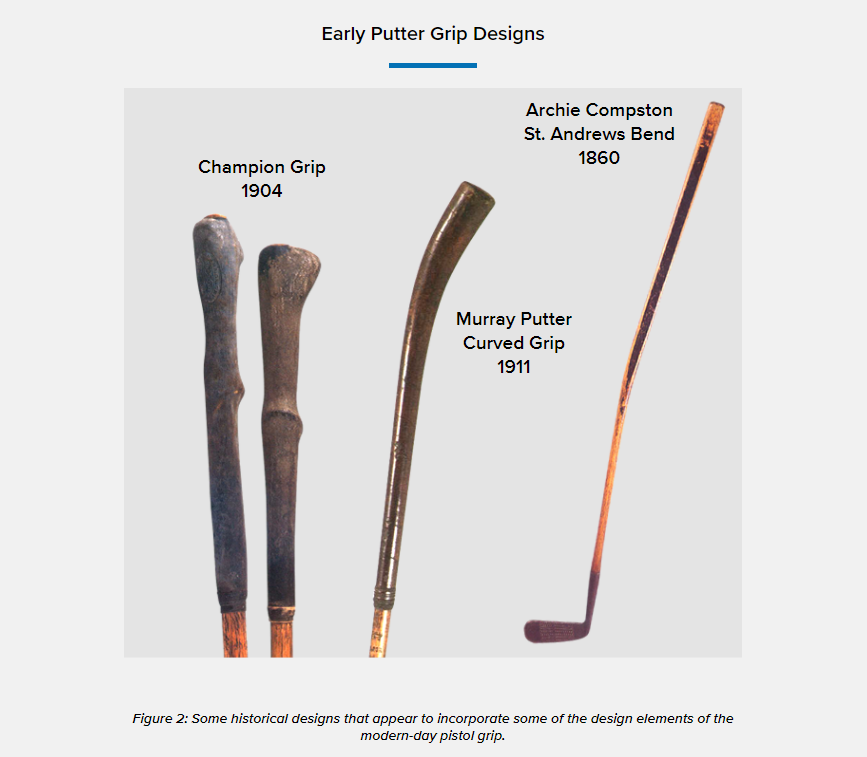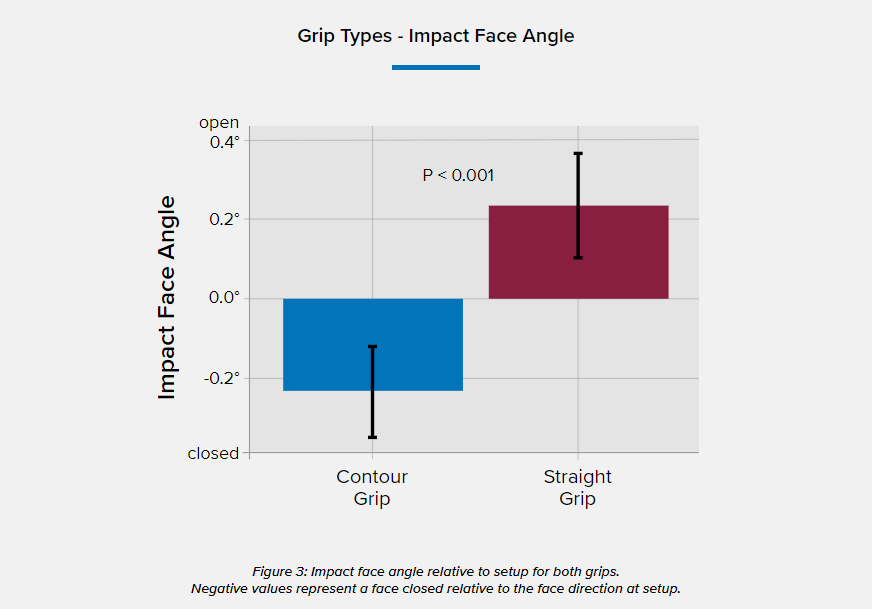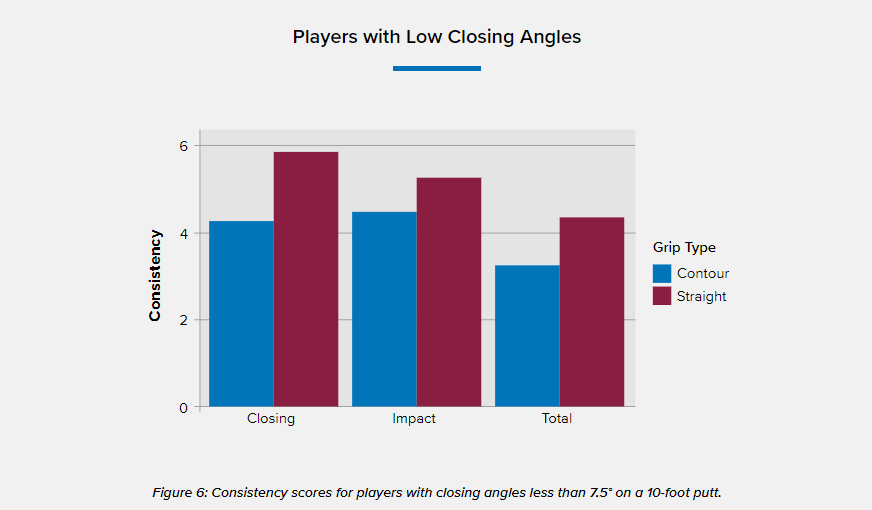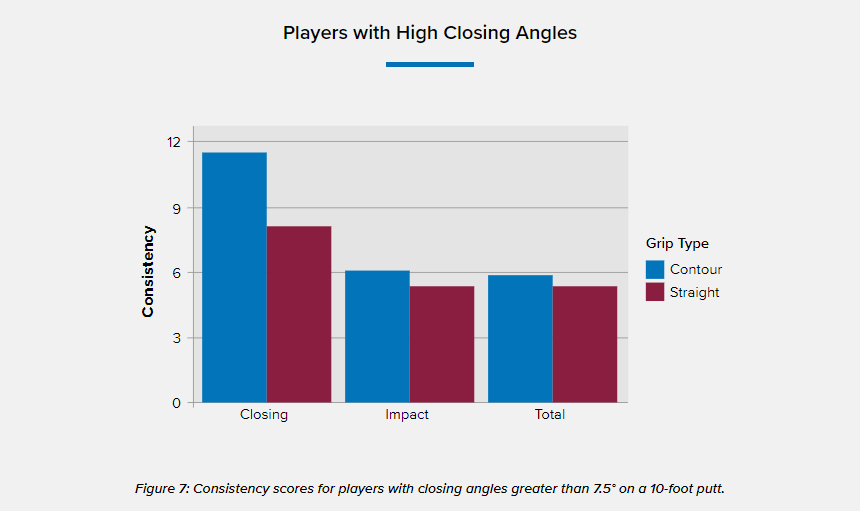ピストルグリップが万能かというとそうでもなくて,フェースローテーションの度合いによってはストレートグリップの方がストロークの一貫性が高まるかもしれないという話。
ソース
PING - Blogs by Erik Henrikson, PhD
拙訳

《ピストルタイプ》のパターグリップのバリエーションは,人々の想像より遥かに長く,ゴルフというゲームの一部でありつづけている。USGAによると,それらは非常に人気があり,「やや伝統的な」パターグリップの形状になっていると,考えらえれている *1。このタイプのパターグリップの特徴として,非円形の断面であり,バット側に近づくにつれてその断面積が増え,グリップの軸がプレーヤー側に向かって傾斜していることが挙げられる(図1)。場合によっては,これらのグリップには角度のついたコアも組み込まれている。 *2
この形状の効果と目的について,異なるアイデアがいくつかある。ピストルデザイン的要素を組み込んだグリップの初期のものとして,1800年代終盤から1900年代初頭のものにさかのぼることができる。断面積が増加し軸がプレーヤー側に傾いているものの例としてふたつある: Champion Grip と Murray Putter だ。Champion Grip は1900年代初頭にさかのぼることができ,成形グリップとしては最初期のもののひとつだ。それは「解剖学的グリップ」とも呼ばれていた。Murray Putter は1910年代にさかのぼることができ,湾曲した木製シャフトとグリップが組み込まれている。斧の握りに着想をえて,Avon Pardoe は同様のグリップの特許を1934年にとった。その謳い文句は,「ボールをより正確に打つことと,グリップする際のさらなるホールド感を保証する」というものだった。1936年,MacGregor は自らのクラブで Pardoe “Rel-Ax” ラバーグリップの提供を開始した。他に注目すべきデザインとして Archie Compston がある。これはシャフトがその中間地点からプレーヤー側に湾曲しているもので,「セントアンドリュース・ベンド」と称された。 *3

これら初期のデザインは,現在知られるピストルグリップに影響を及ぼしたであろうものに,光を与える。これら初期のデザイン同様,こんにちのメーカーの中には,ピストルグリップの端のより大きな形状が,プレーヤーのグリップを「ロックイン」して再現性のより高い動きにつながることを示唆しているものがある。Pingの創設者であるカーステン・ソルハイムは,ピストルグリップを Ballnamic ベントシャフトの代替と見なしていた。Ballnamic ベントシャフトは,それがゴルフ規則によって不適合と見なされる前は,同社のアイアンとパターに組み込まれていた。Ballnamic シャフトの関する彼の哲学は,クラブヘッドのインパクト位置にグリップを合わせ,インパクト時の「ねじれ」を軽減するという意図だった。カーステンは Golf Pride の Informer グリップを自身の複数のモデルに用いはじめ,最終的に Ping PP58 パターグリップを開発して,自身の Ballnamic シャフトの哲学をもっともよく再現するものだとした。このタイプのグリップは長年にわたって支持されているものの,それがパッティングストローク中のパターヘッドのデリバリーに及ぼす影響を調査し発表されたものは,数少ない。ピストルタイプのグリップを「ストレート」グリップ(グリップの全長にわたって断面が均一なもの)と比較したときに,インパクト時のパターヘッドの向きに測定可能な影響があるかどうか。それを調査するパイロット研究が実施された。 *4
手法
40人のプレーヤーが,同じモデルのパターにふたつの異なるパターグリップを取り付け,10フィートから5回パットを行なった。この研究のために選択されたグリップは,Golf Pride Tour SNSR Straight と Contour モデル。一方でパターヘッドは Ping Sigma G Tess を採用した。これらの各セッション中に,Pingパッティングアプリを使用してパターの動きを測定した *5。さらに,プレーヤーは各パターを使用して,1つのホールで8フィートのパットを5回打ち,別のホールでさらに5回パットした。ミスの方向と成功はすべてのパットについて記録された。対応のあるt検定を用いて,特定の従属変数に対するふたつのレベルのグリップの効果を比較した。この研究で評価された従属変数は,アドレスに対するインパクト角,インパクト時ライ角,およびインパクトロフトだった。 *6
統計的有意性は,すべてのテストで<.05に設定された。これは,結果の違いが「本物」か「データのあいまいさの範囲内」なのかを示す,ちょっとした学術的な話だ。異なる条件(たとえば異なるクラブ)で取得されたふたつのデータセットを比較する場合は常に,p値と呼ばれるものが計算できる。結果のセクションにおいて,図の中でこの数値が報告されていることを見るだろう。このp値が0.05未満の場合,ふたつのクラブの間に違いがあるとある程度の信頼度を持っていえる。p値が0.05を超える場合,テストデータからの結論は,問題の変数が両方の条件で本質的に同じであることを示す。 *7
結果
各グリップでのパターの向きを評価すると,ふたつのパターのあいだでインパクト角に有意な差があった。図3にあるように,ピストルグリップではインパクト時のフェース各がセットアップ時に対してよりクローズドである。インパクト時のライ角についても,小さいながら統計的に有意な差があり,これを図4に示している。インパクト時のロフト各には有意な差はなかった。 *8


さらに,8フィートからのパット時の失敗/成功データについても傾向が見られた。つまり,ストレートグリップではピストルグリップに比べて,右に外す傾向がわずかに強まる。しかしこの差は「統計的に有意」ではない。 *9

Pingパッティングアプリの要素のひとつに,パッティングハンディキャップというものがある。これは,パッティングストロークの異なる要素の一貫性をみて,そのブレをハンディキャップの数値で表わすものだ。その一貫性のスコアが,各プレーヤーがそれぞれのパターで5回パットする際に算出された。クロージング各,インパクト角,そして全体の一貫性(テンポ,ライ,ロフトを含む)を,図6と図7に示す。最初のグループはクロージング角が小さい(10フィートのパットで7.5度未満)プレーヤーたちからなり,つまり彼らはストローク中のローテーションが小さいということだ。逆に,ふたつめのグループは,クロージング各が平均で7.5度超のプレーヤーからなっている。 *10
考察
この実験結果から,ピストルグリップではインパクト時のフェース角が――ストレートグリップと比較して――よりクローズドになることが示唆される。8フィートのパットの失敗のデータが示すように,ストレートグリップではインパクト時のフェース角がよりオープンになりやすい。先行研究でも――シャフト軸に対して異なる重心位置をもつふたつのパターを用いてパッティングストロークのキネティクスを調べたもの――,同様の傾向が見られた。ピストルグリップのデザインは,パターの重心に対する手の軸を変えて同様の効果を生むようにし,ヒールシャフトのパターをよりミッドハングパター風にしたものだと言えそうだ。 *11


この洞察から得られるもっとも現実的な応用として,パターフィッティングがある。もしフィッティングしたプレーヤーが気に入るパターがあって,しかしそのミスの方向に傾向があるとしたら,ストレートグリップかピストルグリップかにすることでそのミスの傾向に対処することができるだろう。たとえばあるプレーヤーがいて,ピストルタイプではないグリップがついたAnserモデルが気に入ったとして,プッシュ傾向があるとしたら,ピストルタイプが解決策のひとつになりうる。さらに,ストローク中のローテーションが大きなプレーヤーは,Tessのようなトウハングの強いパターにストレートグリップをつけることで,一貫性を高められるかもしれない。ローテーションが小さいプレーヤーは,Tessのようなパターにはピストルグリップが最適だろう。 *12
参考文献
- USGA Guide to the Rules on clubs and balls, United States Golf Association.
- Ellis, J.B. (1997). The Clubmaker’s Art: Antique Golf Clubs & Their History. Oak Harbor, WA: Zephyr
- Ellis, J.B. (2017). And the Putter Went … PING. New York: C&C Offset
- Cottam, R.J., Wood, P.D., Henrikson, E.M. (2017) Systems, methods, and articles of manufacture to measure, analyze and share golf swing characteristics U.S. Patent No. 9,821,210. Washington, DC: U.S. Patent and Trademark Office.
*1:USGA Guide to the Rules on clubs and balls, United States Golf Association.
*2:Variations of the “pistol-type” putter grip have been part of the game of golf for much longer than one might expect. They are considered to be incredibly popular and have become the “somewhat traditional” shape of putter grip, according to the USGA [1]. This type of putter grip is characterized by a non-circular cross-section where the cross-sectional area increases approaching the butt-end and the axis of the grip tilts toward the player (Figure 1). In some cases, these grips also incorporate an angled core.
*3:There are several different ideas regarding the effect and purpose of the shape. The earliest references of grips incorporating some pistol design elements date back to the late 1800s and early 1900s. Two examples that show an increase in cross-sectional area, with a tilting of the axis toward the player are the Champion Grip and Murray Putter. The Champion Grip dates back to the early 1900s and was one of the earliest molded grips. It was also referred to as the “anatomical grip”. The Murray Putter dates back to the 1910s and incorporated a curved wooden shaft and grip. Inspired by ax handles, Avon Pardoe patented a similar grip in 1934. It was stated that it was designed to “ensure more accurate striking of the ball, and also a greater sense of security in holding the grip.” In 1936, MacGregor started offering the Pardoe “Rel-Ax” rubber grip on their clubs. Another design to note is the Archie Compston putter, which incorporated a bend mid-shaft toward the player and was referred to as the “St. Andrews Bend”.
*4:These early designs help shine some light on the inspiration that may have influenced the pistol grip designs we know today. As with these early designs, some manufacturers today suggest the larger geometry of a pistol grip’s end helps “lock-in” a player’s grip, leading to a more repeatable motion. PING’s founder, Karsten Solheim, viewed the pistol grip as an alternative to the Ballnamic bent shaft the company incorporated into iron and putter builds before it was deemed non-conforming by golf’s ruling bodies. His philosophy with the Ballnamic shaft was to incorporate a bend to align the grip with the center impact location of the club head, with the intention of reducing “twist” at impact [3]. Karsten began using the Golf Pride Informer grip on a number of his models as a result and eventually developed the PING PP58 putter grip to best replicate his Ballnamic shaft philosophies. Although this type of grip has been prominent for many years, there has been little-documented research exploring the effect of this type of grip on the delivery of the putter head during the putting stroke. A pilot study was conducted to explore whether there is a measurable effect on putter-head orientation at impact when comparing a pistol-type grip to a “straight” grip (uniform cross-section over the entire length of the grip).
*5:Cottam, R.J., Wood, P.D., Henrikson, E.M. (2017) Systems, methods, and articles of manufacture to measure, analyze and share golf swing characteristics U.S. Patent No. 9,821,210. Washington, DC: U.S. Patent and Trademark Office.:title
*6:Forty players carried out 5-putt sessions from 10 feet with two different putter grips installed on the same model of putter. The grips chosen for this study were the Golf Pride Tour SNSR Straight and Contour models, while the putter-head model tested was a PING Sigma G Tess. During each of these sessions, the motion of the putter was measured using the PING Putting app [4]. Additionally, players were required to use each putter to hit five 8-foot putts at one hole and five more at another. The miss direction and makes were recorded for every putt. Paired t-tests were used to compare the effects of the two levels of grip on specific dependent variables. The dependent variables evaluated in this study were the impact angle relative to address, impact lie angle, and impact loft.
*7:Statistical significance was set at a < .05 for all tests. This is just a bit of academic speak that states how a difference in result is deemed “real” or “within the fuzz of the data”. Whenever two sets of data taken under different conditions (with a different club, for example) are compared, something called a p-value can be calculated. You will see this number reported in some of the graphs in the results section. When this p-value is less than 0.05, then we can say with a degree of confidence that there is a difference between the two clubs. If the p-value is above 0.05, then the conclusion from the test data is the variable in question is essentially the same for both conditions.
*8:Evaluating the delivered putter orientation data for each grip, there was a significant difference in impact angle between the two putters, as shown in Figure 3, with the pistol grip being delivered more closed relative to setup. There was also a small, but statistically significant difference in lie angle at impact, shown in Figure 4. The delivered loft showed no significant difference.
*9:Additionally, when evaluating the miss/make data for the putts from 8 feet, the recorded data showed a slight tendency for the Straight grip to miss to the right more frequently than the Pistol grip (Figure 5), but the difference was not “statistically significant”.
*10:One element of the PING Putting App is something called a putting handicap. This looks at the consistency of different elements of a putting stroke and equates the variability in those elements to a handicap number. The consistency score was calculated for every player’s 5-putt session with each of the putters. The consistency of the closing angle, impact angle, and total consistency (which includes tempo, lie, and loft) is reported in Figures 6 and 7. The first group consisted of players with low closing angles (less than 7.5 degrees on a 10-foot putt) which basically says they had less rotation in their stroke. Conversely, the players in the second group had average closing angles of more than 7.5 degrees.
*11:The results from this experiment suggest the pistol grip tends to promote a more closed face angle at impact when compared to a constant cross-section grip. Recorded misses on 8-foot putts show some evidence that the players are delivering the face more open at impact with the Straight grip, as opposed to setting up more closed at address. A previous study investigating the kinetics of the putting stroke using two putters with different CG locations relative to the shaft axis showed a similar result. A face-balanced putter delivered the face more closed relative to setup when compared to a heel-shafted putter [5]. It appears the design of the pistol grip orients the axis of the hands relative to the putter CG in a way that produces the same effect, making a heel-shafted putter play more like a mid-hang putter.
*12:The most practical application of this insight is in putter fitting. If a player being fit finds a putter model they prefer, but they struggle with a miss in one direction or another, using a grip that is straight or has a pistol design could help fight this miss tendency. For example, if a player loves his Anser model with a non-pistol grip and is fighting a push, a pistol grip may potentially help. Additionally, the consistency results may suggest players with more rotation in their stroke could perform more consistently with a straight grip on a putter like a Tess, since this maintains the “toe-hang” nature of the design (Figure 7). For players with less rotation in their stroke, a pistol grip may be the best option on a putter like a Tess, since it appears a pistol grip makes the heel-shafted putter play with a little less “effective hang”, leading to better consistency (Figure 6).